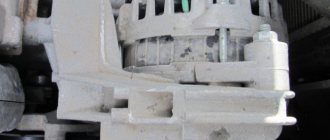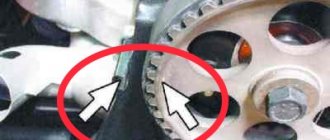Why do LADA owners care about the frequency of replacing the timing belt (gas distribution mechanism) on their cars? Mainly due to the consequences of a broken belt, in some cases the valve bends, which ends in expensive repairs. Let's figure out at what mileage the manufacturer recommends changing the timing belt and rollers, as well as what its actual service life is.
When is it necessary to change the timing belt on a Lada Granta?
The Lada Granta is popular among car enthusiasts in the Russian Federation and many other countries. The power units of this model have a timing belt in the drive of the timing mechanism. Unfortunately, there are cases of its failure, leading to engine breakdowns. Most often, valves bend when they collide with pistons, but sometimes pistons and connecting rods get damaged. All owners of this car model should know when to change the timing belt on a Lada Granta 16 valve, this will help avoid significant costs for major engine repairs.
Some general provisions about the belt
The timing belt in any engine serves to ensure timely intake of the prepared mixture and release of exhaust gases. The composition of this node implies the presence of the following elements:
- camshaft and crankshaft;
- the valves themselves with seals, springs, guide bushings and other parts.
Which timing belt is better? The belt mechanism is positioned separately in this mechanism, acting as a connecting link between the camshaft (or two) and the crankshaft. It is the belt drive that is able to ensure synchronization in the functioning of the elements included in the timing kit.
Finding this important element on the engine will not take much effort. To do this, you just need to open the hood of the Lada Granta and you will see it covered with a special casing. This protection prevents contamination and the entry of foreign objects and dirt.
The design of the belt mechanism includes a rubber base and a working inner surface made in the form of teeth with a certain pitch size.
About Lada Granta engines
To complete this model, manufacturers produce five modifications of gasoline power units. All of them have an injection power system, the working volume of these engines is 1600 cm3. Two modifications have 8 valves in the cylinder head, the rest have 4 valves per cylinder, that is, there are a total of 16 valves in the head. The timing mechanism of all motors is driven by a toothed belt.
Let's take a closer look at the 8 valve modifications of the Lada Granta power units.
- The motor with index 11183-50 has been installed on the machine since the beginning of its production. The VAZ 2111 with minor modifications is taken as the basis. The power of this engine is 82 hp. With. Emissions of exhaust gases into the atmosphere have changed significantly for the better. The engine shows better dynamics and efficiency. The pistons have recesses, so a belt break does not cause damage to the valve mechanism. It is somewhat noisy in operation and requires periodic adjustment of the clearances in the valve mechanism.
- Further modernization of the VAZ 2114 engine received the index 11186. Its power became equal to 87 horses. The connecting rod and piston group of the power unit was subject to changes, the weight of which was reduced by approximately 30%. This not only improved the environmental performance of the engine, but also reduced noise during operation and fuel consumption, but the engine life was slightly reduced. Due to the reduction in piston height, there are no recesses in its head, so a toothed belt break will always be accompanied by damage to the valves.
16 valve Lada Granta engines:
- The VAZ 21126 is a modified engine of the VAZ 21124, which experts consider the best engine of all that are equipped with Grants. The power of the power unit increased to 96 horses. This was achieved by increasing the number of valves per cylinder, which improved the filling of the cylinders with the working mixture and the rapid removal of exhaust gases. The pistons do not have recesses, so bending when the belt breaks will be inevitable.
- The modification of the 21126 engine received the VAZ 21127 index, the power of which became equal to 106 horsepower. The engine began to pull better at low speeds. The problem of valves bending when the valves are damaged remains.
- VAZ 21126-77 is an engine for the Lada Granta Sport, the power of which is 120 hp. With. Apart from the increased power rating, it is no different from the 21126 model. A break in the timing mechanism drive is always accompanied by damage to the valve mechanism.
What is the replacement plan?
Cars of the Lada Granta model line are equipped with different versions of the power unit. Some of them are not without problems in the event of an unpleasant break in the belt drive. This is caused by a collision of pistons with valves, as a result of which the latter are bent and the engine requires repair.
The possibility of bending (if a break occurs) is not available on the “11183-50” version of the motor, which is equipped with the standard equipment.
Further in this material we will look at versions of motors that have such a feature as bending of valves when the belt drive breaks. And let's try to understand which timing belt is better.
Another important question: when to change the timing belt? To eliminate this unpleasant situation, the manufacturer deliberately regulates the periodic period of mandatory replacement of the specified “consumables”. The answer to the question of how long it takes to change the timing belt from the manufacturer is after 15 thousand kilometers. This requirement applies to both 8-valve engines and their 16-valve modifications.
Even despite the fact that the “21116” modification is equipped with a motor with an imported head, if the belt breaks, a similar sad fate awaits it.
The manufacturer does not recommend independently carrying out the procedure for either checking the condition of the belt or replacing it. And therefore, when the time has come to change the timing belt, you should contact a service center. If it is revealed that the indicated operation was performed manually, there is a high probability that the owner will be deprived of the possibility of warranty service. For self-replacement, the manufacturer provides permission regarding:
- cabin filter;
- a similar element for the intake system.
However, many car owners still carry out the replacement on their own, but not all new drivers know how long it takes to change the timing belt, and also which timing belt is better than the rest.
Factory regulations for timing of timing belt replacement
Each vehicle manufacturer specifies the timing of maintenance and other routine maintenance. According to this document, replacing the timing belt on a Lada Granta car should be done when the car has driven no more than 75 thousand km . In fact, this figure does not always correspond to reality; there are a number of reasons for this. The service life of a timing belt will depend on:
- The quality of the product used.
- Vehicle operating conditions.
- Technical condition of the engine.
- "Age" of the timing belt.
Much attention is paid to the manufacturing quality of rubber products, but the quality of parts from different manufacturers varies greatly. The main supplier for VAZ is the RTI plant, which is located in Balakovo. In addition to it, engines can be equipped with products from other companies such as Gates, ContiTech, Trialli, Bosch, and some others. You should carefully consider the product you are purchasing, since you can buy a fake under the guise of products from well-known manufacturers.
The operating conditions of the vehicle, especially its engine, also affect the service life of the timing drive. In 16 valve modifications, the load on the belt teeth increases, so it requires more attention. Fuel and technical fluids are not allowed to enter the operating area of the timing mechanism drive. They soften the body of rubber products, make the material pliable, and the teeth are easily cut off. At the slightest manifestation of leaks in the operating area of the timing drive, they must be eliminated immediately.
The teeth of the crankshaft gears and camshafts gradually wear out, and the height of the teeth decreases. This means that the contact area with the belt becomes smaller, making it easier to tear off the toothed belt comb. The coolant pump can also become a source of trouble for the timing drive. Sometimes it jams, and since the pump is rotated by a toothed belt, its teeth are cut off.
Which kit to buy
In addition to the toothed belt, a tension roller and a coolant pump are purchased. The main supplier of rubber products is the RTI plant in Balakovo. Products from GATES, BOSCH, DAYCO, CONTITECH have proven themselves well. If the pump in the engine cooling system is replaced, antifreeze will be needed to top it up.
A broken timing belt and its subsequent replacement is a fairly common problem among owners of a Grant car, both with an 8-valve engine and with an engine with 16 valves installed.
Very often among car enthusiasts you can hear a conversation that, due to a torn belt, the engine seized or the valves were “bent”. Why this happens and how to prevent such a phenomenon, as well as how to change the part yourself, will be discussed in our article.
Signs of a Worn Belt
You can avoid expensive repairs by monitoring the condition of the parts in the timing mechanism drive. This will make it possible to timely detect the beginning of the process of destruction of parts in the drive and prevent the creation of a situation where motor repair is required. First of all, pay attention to the condition of the product and its wear. If wear is high, heavy loads or high ambient humidity can cause the belt to slip.
Increased wear can cause deviation towards the tension roller and strong heating due to a failed bearing. Protruding shreds of drive material indicate that wear has begun. The owner should be alarmed by the appearance of cracks; the greater the number of such damages, the shorter the remaining service life of the product. If the outer side of the belt appears shiny, it indicates a loss of elasticity and must be replaced. If the drive has lengthened to such an extent that its tension cannot be adjusted, the belt must be replaced.
Source
How to determine that a break may soon occur
Urgent replacement of the timing belt for a Granta car of 8 and 16 cl. may be necessary if the following phenomena occur:
- Decrease in vehicle power. A poorly tensioned or worn drive can make the engine difficult to start and reduce power output.
- Incomprehensible noises from the timing belt on the Grant, emanating from the engine compartment. Clunking, ticking or strange rustling noises often indicate that the Granta timing belt is damaged and rubbing against the casing or other parts under the hood
- Visible damage. The part may have abrasions, cracks and “shaggy” areas that are visible to the naked eye.
If, upon careful inspection, it is discovered that the teeth on the Grant timing belt have been cut off or at least one of the other listed problems, it is necessary to urgently replace the part with a new one, which is quite possible to do yourself.
AVTOVAZ recommendations
It is immediately worth noting that on the official LADA website in the maintenance calculator (it is only up to 90 thousand km) nothing is said about replacing the timing belt and rollers. However, information about this is in the service book of some LADA models.
Lada Priora:
No information available.
- The 2015 service book indicated that for the 8-valve engine, replacement is provided at a mileage of 75,000 km.
- The 2022 service book states that the timing belt, tensioner and support roller (if equipped) should be replaced at a mileage of 180 thousand km.
- From June 2022, the timing belt must be replaced at 90,000 km.
- Engine Renault K4M (1.6 16V). The timing belt and rollers should be replaced at 120 thousand km or 6 years.
- Engine VAZ 11189 (1.6 8V). The timing belt and rollers should be replaced at 160 thousand km or 8 years. It is noteworthy that the Lada Vesta service book (until 2022) indicated that on the VAZ-11189 engine, replacement is provided at a mileage of 180,000 km (until 06.2021) or 90,000 km (from 06.2021).
- Engine VAZ-21129 (1.6l., 16kl.). The timing belt along with the rollers should be replaced at a mileage of 180,000 km (until 06/2021) or 90,000 km (from 06/2021).
- Engine VAZ-21179 (1.8l., 16kl.). The timing belt along with the rollers should be replaced at a mileage of 180,000 km (until 06/2021) or 90,000 km (from 06/2021).
- AVTOVAZ periodically changes the regulations for replacing timing belts and rollers.
- From June 2022, according to the regulations, the timing belt must be replaced at a mileage of 90,000 km.
Checking condition and tension
As already noted, so that a belt break does not lead to serious problems, it is necessary to periodically check its condition and tension.
Checking the condition of the belt is quite simple and you can do it yourself.
To do this, you need to unscrew and remove the protective drive covers, jack up the front right wheel, engage a higher gear and spin the wheel.
The engaged gear will ensure rotation of the crankshaft and timing drive through the gearbox.
When rotating, you must carefully inspect the belt. If any defects or signs of wear are noticed on it - torn teeth, peeling of rubber from threads, cracks, significant abrasions, then the belt must be changed regardless of the mileage.
Additionally, when checking the condition of the drive, its tension should also be assessed.
Although the Grant uses a roller with automatic tension, you cannot rely on the fact that it works normally and it is better to check the tension, especially since it is very simple to do.
The belt must be taken with two fingers in the middle of the area opposite the tension roller, that is, on the span between the shaft pulleys and turned clockwise.
Moreover, if even with significant force it is impossible to twist it at an angle greater than 90 degrees, then the belt is tensioned normally. If it twists at a larger angle, then it is necessary to adjust its tension.
Replacing the timing belt on the 8-valve Lada Granta: engines 11183 and 11186
All the latest models of front-wheel drive cars produced by the car plant located in Tolyatti have a timing belt in the gas distribution mechanism. Lada Granta fully applies to these models.
The machine is equipped with several modifications of engines, which can have 8 or 16 valves in the cylinder head. Many owners service and repair this model themselves, so it will be useful for them to learn how to change the timing belt on a Lada Granta with 8 valves.
general information
Most often, the timing mechanism is located in the front of the car; in older car models it can be found between the engine cylinder and the radiator. Today, manufacturers are trying to reliably hide the part, however, to find it, you just need to unscrew the protection and start repairing. The composition of the element is a rubber mixture. Many manufacturers use highly saturated nitrile, which provides excellent wear resistance at high temperatures. There are teeth on the inside. Manufacturers produce their own type of belts for each car model.
A broken belt will cause many problems for your car. The whole point is that the part uses basic systems. When it breaks, the shaft freezes in one position. The pistons continue to move, hitting the valves and deforming them. The consequences can be dire.
The main reasons for the break:
- An unscrupulously assembled car engine.
- Severely worn mechanism.
- The elasticity of the material has deteriorated significantly - rupture occurs.
- Poor quality workmanship of the part.
- Pump rollers are not tensioned well.
About engines
Lada Granta engines with 8 valves in the cylinder head are indexed 11183 and 11186. The first of them began to be produced in 2004, the second later, namely in 2011. The power of the “83” unit is 82 horses, with 87 hp for the “86” modification. Motor 11186 is an improved engine of the “83” model. It uses a lightweight connecting rod and piston group. It was possible to achieve a reduction in the mass of the piston group by almost 30%. The cylinder head is subjected to specific heat treatment, which increases its strength and wear resistance.
The cooling system of the power unit also received some changes. The skirts of lightweight pistons are coated with graphite lubricant, this avoids the appearance of scuffing on the cylinders of a cold engine. The compression ratio of the “86” engine became 10.5 versus 9.6 for the “83” modification. The cylinder head gasket of the new engine is now thinner, it is 0.43 mm versus 1.2 on the old model. The diameter of the intake valves was increased, which improved the filling of the cylinders with the air-fuel mixture.
Does the valve bend?
Unfortunately, this problem exists for the Lada Grant. It appeared from the moment the production of the first cars with front-wheel drive, the VAZ 2108, began. Subsequently, the working volume of the power unit of this model was increased, it became equal to 1.5 liters. The engine index became 21083, in which the pistons have a recess in the head. This made it possible to prevent the pistons from meeting the valves if the timing belt in the timing drive breaks or is installed incorrectly. This particular power unit was taken as the basis for the engine for the Granta, so there were no valve bends.
Upgrading this engine to model 11186 involves installing lightweight parts of the connecting rod and piston group. The pistons have become shorter in height, which does not allow making recesses in the head to prevent them from meeting the valve. Therefore, a toothed belt break is always accompanied by damage to the valves on an 8-valve Grant, sometimes to connecting rods and pistons. This problem accompanies all subsequent modifications of engines for the Lada Grant.
What are the expected consequences of a break?
As stated, no problems with the Lada Granta engine in the 8-valve version, or if the belt drive breaks, arise only in the version of the “11183-50” unit. The remaining engines are at risk of failure in the event of a designated unpleasant incident. In view of this, a dispute arose among the “Grantavods” regarding the advantages of LADA Granta engines with 16 and 8 valves, and which unit has more of them. Your point of view will also be very interesting.
If the belt drive breaks, the camshaft stops in the position corresponding directly to the moment of failure. In contrast, the crankshaft is subject to continued rotation. This causes the pistons to hit the valves that were in the open position at a given moment. Then the latter bend, but sometimes a breakdown of the piston bottom occurs. Popularly called “fist of friendship”!
It is based on this fact that experts are inclined to recommend changing the timing kit before the period stated by the manufacturer for this action.
Replacement procedure
Many owners of this car prefer to carry out this operation in specialized workshops, but some do it themselves. There is nothing overly complicated in this procedure; there is no need to purchase special equipment or devices. You can replace the timing belt yourself in the garage. You will need to prepare a set of wrenches, a mounting shovel, a jack, a stand for the body, wheel chocks, gloves, and rags. Round nose pliers with curved ends are suitable as a key for adjusting the tension roller.
Replacing the timing belt on a Lada Grante is performed in approximately the following sequence:
- The car is placed above the inspection hole or on a flat surface, the handbrake cable is tightened, and wheel chocks are installed under the rear wheels.
- Open the engine compartment hood and disconnect the terminals from the battery.
- The generator set drive belt will interfere with work, so it is removed.
- Now, using the hex number “5”, remove the four screws that secure the front protective cover of the gas distribution mechanism drive.
- To avoid accidentally damaging the crankshaft position sensor, it should be removed from the cylinder head and set aside. Do not allow metal filings to come into contact with the sensor; they may further distort its readings.
- Next, you need to set the piston of the first cylinder to the top dead center position.
- Removal of the toothed belt is hampered by the generator drive pulley on the crankshaft, which must be removed. To do this, tear off the wheel bolts of the right front wheel and raise the body with a car jack.
- A stand is installed under the body, the wheel is removed, and the protective shield is on the mudguard.
- An assistant is needed to remove the crankshaft pulley. Ask him to engage fifth gear and press the brake pedal hard. Some experts insert a powerful screwdriver into the hatch on the transmission housing between the teeth of the flywheel.
- Applying some force to the head “17”, unscrew the bolt and remove the pulley from the crankshaft.
- You will again need the fifth hexagon number, with which you need to unscrew the three screws of the lower protective casing of the timing mechanism, after which you can remove the protection.
- Now you need to loosen the tension roller fixing bolt; a 15 mm spanner is best suited for this. After this, the roller will rotate and release the tension of the drive belt, which is easily removed from the gears and taken out of the engine compartment.
Important! After this, you cannot turn the engine crankshaft to prevent the pistons from meeting the valves.
Typically, the belt is replaced together with the tension roller and coolant pump, so they must be removed from the cylinder block. There is an adjusting washer under the roller, which is installed back during assembly. When removing the pump, pour a certain amount of antifreeze into a previously prepared container. Installation of a new timing belt is carried out in the reverse order. Please note that you need to check the position of all installation marks on the crankshaft and camshaft, cylinder block and timing belt guard.
Why does a belt suddenly break?
In some cases, even a new part can suddenly break, causing a lot of inconvenience to the owner of the vehicle. Most often, the teeth are worn out due to the fact that the Grant timing belt was installed incorrectly. In this case, it runs crookedly on the pulleys and rollers and its teeth “eat” the metal elements of the pulleys.
Other causes of premature wear may include:
- Poor part quality. In this case, savings can play a cruel joke on the driver, so you need to make a purchase in trusted stores
- Pump malfunction. This is one of the most common causes of breakdown. The pump rollers break over time, forming a gap and displacing the axis. As a result, its teeth quickly wear out and lead to breakage.
- Tension roller malfunction. The same thing can happen with a roller as with a butt. A bearing failure creates play and displaces the tension axis.
- Oil or antifreeze leak. When technical fluids get on the belt, they destroy the rubber from which it is made and greatly affect the strength of the part.
- Wear of pulley teeth. If the camshaft or crankshaft gears are severely damaged, integrity will be immediately affected. In this case, the teeth will have delamination on their surface.
In addition to all of the above, the fact that the timing belt on the Lada Granta 8 suddenly breaks can be caused by a trivial reason for its untimely replacement.
Related link:
How to make an armrest for a Lada Granta yourself. Recommendations from professionals
If the frequency of replacing the Lada Granta timing belt is not correct, then the driver should count not only on purchasing a new one, but also possibly on a complete engine repair. The cause of the rupture can be diagnosed according to the following scheme:
How long does it take to replace it?
The factory operating instructions for the vehicle recommend replacing the timing belt after a mileage of 75 thousand km. This standard is not always followed by owners, and there are good reasons for this. How long the drive lasts before replacement depends on many factors. This is the quality of the parts used, the operating conditions of the vehicle, and the technical condition of the engine. During each maintenance, the tension and condition of the timing drive should be checked. If cracks, peeling, or other damage appears, the belt should be replaced.
With a high mileage of the car, natural wear of the crankshaft and camshaft pulleys occurs, this significantly reduces the service life of the entire timing drive. The drive is also afraid of engine oil getting into the belt operating area. It softens its structure, the teeth are easily cut off. If the car has been sitting idle for a long time, it is also better to replace the drive due to its aging. Most owners and experts recommend changing the belt after a mileage of 50 thousand km.
conclusions
Now you know how long to change the timing belt. Undoubtedly, a broken LADA Granta belt is a source of unprecedented problems. This circumstance does not mean that you need to remain inactive. Below are a few recommendations whose goal is to minimize this risk.
1. Be very careful when checking the belt for wear. This action is recommended to be carried out after 10-15 thousand km.
2. Do not neglect checking the condition of the seals. The defect manifests itself in the form of characteristic spots under the bottom of the car.
3. The flashing of the lamp that registers the oil pressure in the LADA Granta engine may indicate a problem. If this fact manifests itself, we urgently turn off the engine and take measures to find the source of the breakdown.
4. Use only original spare parts, although no one has canceled the procedure for monitoring their condition.
Dear GrantaVody. Tell me who has encountered...
My friend Grant has 1.6 - 8kl. (norm). Mileage 70,000. The timing belt broke - the valves were bent... Question. Since the grant itself, how long is it better to change the timing belt? What is the approximate cost of repairs? in case the belt has already broken and the valves are bent, and the cost of the belt itself.
I read somewhere on the Internet that at 1.6 - 8kl - if the timing belt breaks - the valves do not bend.
RAVE?
Owner reviews
How long does a timing belt last in practice? Belt breakage does happen, but rarely. Here are a few examples when the timing belt broke at low mileage:
The Za Rulem magazine, which has LADA models in its editorial fleet, encountered the problem twice:
- Datsun. Timing belt teeth cut off on an 8-valve VAZ engine at a mileage of 67,695 km.
- Lada Granta. Breakage due to poor quality of the belt at 97,000 km.
Recommendations
. The reasons for a broken timing belt can be different. For example, due to the low quality of the rubber product itself or due to the pump jamming. To avoid costly repairs, it is recommended to regularly (every maintenance) check the condition of the timing belt, especially if the mileage is more than 60,000 km.
How often do you recommend changing the timing belt and rollers? Take part in the survey and leave your feedback in the comments.
Where can I buy
: Timing belt kits at low prices are available in our online store (Timing belt category).
Source











